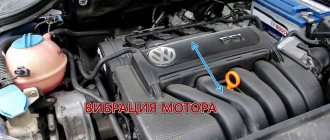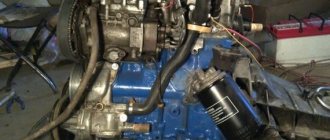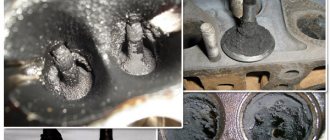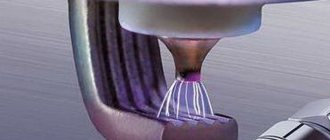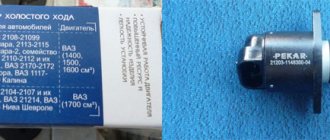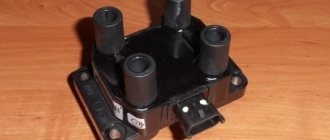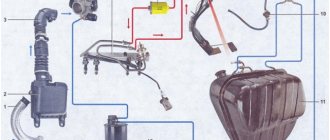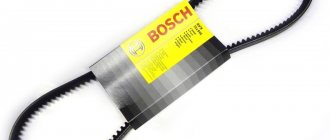Solution methods
When the reasons for the throttling of the injection-type VAZ 2107 engine have been determined, you can proceed directly to analyzing options for eliminating the problem. Before you begin, you need to understand that you need to know the design features of the motor.
But the 2107 engine is so simple that even the most inexperienced motorist will figure out what’s going on. So, let's look at how to remove the injector tripping of a VAZ 2107 engine.
Fuel pump and filter
The first place to look for the cause begins with the fuel supply. First, you should check the fuel pump for functionality and whether there are any malfunctions. If this element does not show visible signs of damage, then it is recommended to disassemble it and check it.
Many experienced car enthusiasts advise, after the fuel pump, to start replacing the fuel filter element, since this is where fuel can poorly pass to the injectors. The fuel filter, according to the service documentation, must be changed every 30-35 thousand kilometers.
Injectors
The next place to look for trouble is the injectors themselves. They may be clogged due to the use of low-quality fuel or defective due to their service life, in other words, worn out.
The elements are checked using a special stand, which not only diagnoses the condition, but also cleans the elements. If there is a damaged or worn part, it is better to replace it with a new element.
Spark plugs and high voltage wires
Loss of spark can also lead to engine malfunction. The next unit that needs to be examined is the ignition. First of all, it is recommended to diagnose the spark plugs. To do this, you need to pull them out from the block head and visually inspect them for cracks. Next, it is recommended to clean the spark plugs from accumulated dirt.
It is worth noting that it is necessary to pay attention to the condition of the spark plug contacts. If they are in oil or have heat, then the problem is not only the engine tripping.
The next stage of diagnosis is to ring the contacts using a multimeter and measure the gap. In most cases, such diagnostics show that the spark plugs are not suitable for further use and should be replaced.
Another element of the ignition system that directly affects the ignition of the air-fuel mixture is high-voltage wires. How well and economically the motor will work will depend on their condition. Therefore, it is recommended to inspect them for damage and also test them with a multimeter.
Air filter
A dirty air filter can lead to the engine not receiving enough air into the combustion chamber, and accordingly the formation of the air-fuel mixture will be disrupted. Therefore, it is recommended to inspect the element, and if it is found that it is dirty, it must be replaced.
Throttle
A dirty throttle valve also prevents the normal flow of air into the engine. To diagnose the unit, it is necessary to dismantle it. If you find that dust and other foreign objects have accumulated on the walls, you should clean the part. To do this, you will need a special product or liquid for cleaning carburetors. This operation can be performed by any car enthusiast without any problems.
valves
Burnt-out valves can cause the engine to start to misfire, since a gap is formed between the seat and the exhaust valve, through which exhaust gases flow back into the combustion chamber, thereby disturbing the balance in the air-fuel mixture.
To diagnose the unit, it is necessary to dismantle the block head. Often, already burnt-out valves are the first sign of wear on the piston group, and accordingly everything leads to a major overhaul.
ECU and sensors
The last place to look for a problem is the sensors. Thus, failure of one or more measuring elements can cause a tripping effect. Therefore, the motorist will have to check them manually, since the electronic control unit cannot always recognize that the sensor has failed.
The electronic engine control unit can also cause tripping. Accumulated errors or damage in the software will disrupt the operation of the entire system. To diagnose and troubleshoot the problem, it is recommended to contact specialists.
Knock Sensor
If a car has a knock sensor, it is responsible for dampening strong engine vibration through dosed fuel supply, thereby ensuring fuel savings (about 9%).
In addition to the above, the reasons may be: open or short circuit, mechanical damage to the wiring, slippage or breakage of the gas distribution mechanism, external overheating, increased induction fields, moisture, etc.
If you are not confident in your abilities, do not under any circumstances start troubleshooting, seek the help of professionals, especially since today ECU diagnostics are inexpensive, and based on the readable error code, it allows you to accurately identify the faulty engine unit.
No amount of savings on repairs will help you if you face the risk of serious problems.
VAZs, like the vast majority of modern cars, have a lot of different sensors that monitor engine performance. Like other engines, the power unit of the latest VAZ models has an ECU (electronic control unit), which, if faults or disturbances in the operation of the internal combustion engine are detected, can issue an inscription that many motorists are very afraid of. As you understand, we are talking about Check Engine
, this is an error that means “check engine”, literally.
There is no need to despair over this error, as it can often indicate minor problems, such as bad fuel or the need to replace spark plugs. But unfortunately, there are situations when Check Engine can mean the “death” of the engine, so this error cannot be taken lightly, and at the first opportunity it is necessary to check all components that may be involved in the appearance of this error.
Check Engine sensors
" appeared in the 80s, they were invented to monitor the operation of the carburetor, so if the Check Engine light came on, it could only mean one thing - the carburetor was faulty. Over time, this “light bulb” was followed by other malfunctions that were already associated with malfunctions of the engine, as well as its various systems. Consequently, with the advent of new “responsibilities”, interpreting the appearance of the Check Engine has become quite difficult. The Check indicator lights up after the ECU detects problems with the engine. Various sensors report this to him, based on this the first conclusion can be drawn - the Check Engine can light up even if the sensors themselves malfunction.
It is normal for a Check Engine
after you turn the key in the ignition, after you start the engine, the inscription should disappear, if this does not happen, read about the reasons why this error may appear. When you start the engine, the ECU checks all systems and if there are no problems, the Check light goes out, but if the computer finds a breakdown, the light will not go out until you fix the problem or make an error.
The engine is shaking, the check is flashing or on: the main causes of the malfunction
Most of the listed faults can be solved solely by transporting the car to a service center, followed by transferring it into the hands of an experienced technician. However, some of these problems can be solved independently, if you have the proper knowledge and skills. Read on to learn why the check engine light may blink and the engine stalls.
Engine tripping
Engine tripping is one of the malfunctions in the operation of the internal combustion engine, when one or more cylinders do not work partially or completely. This phenomenon is observed in the event of disturbances in the combustion process of the fuel-air mixture. The result of the malfunction is unstable operation of the engine, both at idle and under load or in transient modes. The list of main causes of engine tripping includes:
Elimination methods
Different brands of vehicles require the presence of various methods of self-diagnosis, triggered through some special technical measures. In some cars, you can find out why the check engine light is flashing by turning the key and pressing the gas pedal a certain number of times. Other vehicles are equipped with an on-board display, which displays information about all violations of the propulsion system. If the check light is on on a VAZ car, the driver will need to close certain contacts in the diagnostic connector.
An excellent option to help determine the reason for the activation of the Check Engine light in almost any type of car is to use specialized equipment. The OVD-2 automobile scanner, which can be purchased at almost any specialized center, will help to regularly check engines for any malfunctions.
The most accessible way to reset errors in a vehicle’s on-board computer is to disconnect the terminals from the battery for 1-2 minutes. After carrying out such activities, the memory of the electronic unit will be cleared, and the indicator will stop lighting by itself.
Reset errors
Today, one of the most accessible ways to reset errors and turn off the Check Engine indication is to visit a special specialized service. All necessary procedures will be performed by experienced craftsmen, using all kinds of appropriate equipment.
However, there is also a traditional folk method that allows you to reset errors and get rid of the blinking check without visiting specialized service centers. To turn off the annoying light bulb, the car owner must take the following set of actions:
Please note: this method will only help you if the cause of the Check Engine activation has already been resolved. If you have not gotten rid of the breakdown that caused the check light to turn on, then after all the machinations it will light up again.
What to do if the engine fails? We diagnose and repair!
As many people know, an internal combustion engine is a rather complex mechanism that needs to be regularly maintained and repaired from time to time. Otherwise, some problems may appear during operation. Drivers often feel that the engine becomes more difficult to start, its power decreases, gasoline consumption increases, unusual sounds and vibrations arise, and the engine begins to operate unstably.
You need to remember that if the engine of a VAZ 2107 is misfiring, this is a serious breakdown that needs to be fixed urgently so as not to lead to more complex problems. In this article we will discuss how the breakdown manifests itself, what the causes may be and how to eliminate them.
Five signs of tripling
It is very important that the fault is diagnosed in a timely manner. Then you need to isolate the problem as quickly as possible so that repairs can be made.
So, if the VAZ 2107 engine has trouble with the carburetor, the reason for this may be the malfunction of one of the cylinders. Sometimes several cylinders fail at once. In fact, this is due to the fact that for some reason the working mixture does not ignite in the combustion chamber of an idle cylinder, or it does not burn completely.
We list five signs of engine tripping in a VAZ:
Even if you notice only one of these symptoms, you urgently need to understand what was the source of the breakdown. The point is that equipment failures cannot be ignored. After all, delay can lead to more serious problems that will require expensive repairs.
Reasons for the appearance of Check Engine on VAZs
- The first reason, quite popular in our area, is bad gasoline. Often the check light comes on precisely because of poor fuel. This can be treated by draining the “bodyagi” and refueling with normal gasoline; if you feel sorry for gasoline, you can just wait until it runs out and refuel elsewhere with normal quality fuel.
- Candles. Damaged or faulty spark plugs can cause a Check Engine Light. For example, if the spark plug has an incorrect gap or the insulator is cracked. The solution is to check or replace the spark plugs.
- Low fuel level, gas tank cap not tightly closed. In both the first and second cases, a problem will arise with the pressure in the fuel system, after which the ECU will report the problem in the form of the appearance of a corresponding inscription.
- Problems with the ignition coil. The lack of a spark will lead to misfires in the cylinders, and the lambda probe will report an error to the control unit. The solution is to check the ignition coil and replace it if it is faulty.
- Problems with the lambda probe itself (oxygen sensor). In this situation, repair is impossible; as a rule, there is only one way out - replacing the oxygen sensor. You can, however, try to clean the Lambda Probe, but it is not a fact that this will lead to anything.
- Catalyst malfunctions. Most often, this breakdown occurs on cars with decent mileage. The catalyst is killed as a result of oil problems when the engine takes oil. The oil consumption does not go unnoticed; the remaining oil does not burn completely and is deposited on the catalyst honeycomb. Also, problems with the catalyst can arise due to poor fuel or due to mechanical damage to the catalyst. This problem can only be solved in one way - by complete replacement.
- Problem with injectors. The injectors may simply be clogged; the problem can be solved by flushing the injectors. If this does not help, the injectors will have to be replaced.
- There are malfunctions in the fuel system, the fuel pump is acting up, the fuel coarse filter or fuel filter is clogged. To confirm or refute this assumption, it is necessary to measure the pressure in the fuel rail and check the fuel pump.
- It happens that the Check Engine lights up due to problems with the BB wires. If there is a suspicion of their malfunction, it is necessary to check the high-voltage wires and, in case of malfunction, replace them.
- The mass air flow sensor (MAF) is often the reason why the “Check Engine” lights up. In order to find out if there is a problem with the sensor, you need to check the mass air flow sensor. If it turns out that the sensor is faulty, replace it.
Causes of malfunction
Why does the engine in the VAZ 2107 suffer from injector problems?
If the driver observes signs of malfunction in the operation of the cylinders, it is necessary to diagnose the operation of the power unit. There are five most common reasons:
I would like to say right away that there may be many more reasons. And without high-quality diagnostics, it is not always possible to determine exactly what the problem is. But in this article we will discuss the most common faults in most cases, which in 90 percent of cases drivers can detect and fix on their own.
Reason 1: problems with the ignition system
One of the main reasons for engine stalling is a failure in setting up the ignition system. If you listen carefully to how the motor operates, you can hear popping noises accompanied by slight twitching of the motor, which indicates that one of the strokes is missed.
If these signs appear at idle, but after the crankshaft is spun, the engine becomes stable, this indicates early ignition. This means you need to adjust the ignition setting.
If everything is set up well, you can check the spark plugs. In most cases, it is faulty spark plugs that cause the engine to stall on all VAZ models. The best option is to completely replace the kit with a working one.
It is important to note that different spark plugs are suitable for different engines. For example, you need to pay attention to the heat rating and other important design features. In rare situations, when it is not possible to urgently change the spark plugs, but you have to drive, you can temporarily clean what you have and make sure that the gap is set correctly.
Often, at the same time as the spark plugs, the spark plug wires also become unusable. Therefore, they also need to be checked and, if necessary, replaced.
It happens that the engine starts to stall after rain. This may indicate problems with the explosives. To diagnose, you need to start the engine in the dark and inspect the high-voltage wires.
If a spark appears, this indicates that the insulation is broken. You can temporarily solve the problem by wrapping the sparkling area with electrical tape. But this solution is temporary until the nearest auto store!
Sometimes the car starts to jerk only after warming up. It starts and warms up reliably. This may indicate that there is a problem with the ignition coils.
Reason 2: violation of the formation of the working mixture
If the ignition system works like a clock, but the problem still remains, it’s time to pay attention to the mixture formation system. Perhaps it is not entering the cylinder. Or for some reason the fuel mixture does not want to ignite. The fact is that only at certain proportions of air and fuel does a spark lead to ignition. A lean or rich mixture will not burn. The engine begins to operate unstably when cold or warm, at idle or under load.
The problem could be quite simple: a dirty air filter. Often it is enough just to replace it with a new one, and the car begins to please its owner again.
Fuel sometimes begins to flow in excess quantities. This may indicate that the injector nozzles are starting to overflow. This means it’s time to check the operation of the entire injector.
When depressurization occurs, excess air can enter the system, which leads to a lean fuel mixture. Air congestion is also caused by the fact that the operation of the vacuum brake booster is disrupted.
Reason 3: failure of the engine itself
In order for the engine to operate stably and the working mixture to be burned as efficiently as possible, the cylinders must be well sealed during the stroke. If the operation of the cylinder-piston group or gas distribution mechanism inside the engine is damaged, this can lead to problems in the operation of the gas distribution system, which leads to partial depressurization.
If the piston rings are stuck or completely destroyed, if the piston itself is damaged, if scuffs or cracks appear on the cylinder walls, or if the valves of the gas distribution mechanism are burnt out, all this can lead to the fact that the piston simply will not be able to properly compress the combustible mixture.
To diagnose a malfunction, compression is measured in all cylinders. If the compression indicator drops in only one of them, it will be enough to pour a little oil there and take the measurement again. When the compression rises, you can judge about piston problems. If there is no change in the compression level, then the valve has burned out.
Sometimes the cause of low compression is incorrect valve adjustment. It would be a good idea to check the condition of the rocker or hydraulic compensator. A malfunction can result in the valve simply not fitting tightly to the seat.
Sometimes, to eliminate the problem, it is enough to correct the general adjustments of the gas distribution mechanism. For example, it is important to monitor the valve timing settings.
why is the check engine light on vaz 2107
Almost all modern cars have a special check engine light on the dashboard, which literally means Check the engine. When the light in question is activated, it means that the driver should know that the control unit has noticed a certain kind of problem in the operation of the system. Initially, back in the eighties, cars were equipped with miniature computers that were created to control the carburetor, but then the scope of their application became much wider. From now on, these control units monitor not only the composition of the mixture, but also engine speed, ignition timing and other parameters, including the moment of gear shifting in an automatic transmission.
Therefore, there are quite a few reasons that may explain why the check engine light came on. So, the check engine light came on, what should I do? First of all, you should remember that this light always comes on immediately when you start the engine, but if it is working properly, it goes out almost immediately. If you notice that the check engine light is on and does not go out, you need to take the warning into account, but you should not stop, because the problems can be quite harmless. For example, this could be the loss of a gas cap. In any case, at the first opportunity you should analyze the condition of the car in the car showroom. When the check engine flashes while the vehicle is moving, there is no need to panic.
Stop the car and check the sounds the engine makes when running, check the oil level if necessary P and look for visible defects or damage on the engine. If problems were not detected during the initial diagnosis, calmly get to a car service center, where a complete professional diagnosis will be carried out. If the car is functioning properly, but the check engine light is still on, then the reason is most likely a misfire in one of the spark plugs. Often, such a malfunction is typical for cars that drive specifically in Russia, since the quality of gasoline in this country is not particularly high.
This reason is one of many that cause the Check Engine light to come on. The most reasonable decision on the part of the driver is to contact an automotive diagnostic center. It is worth recalling that there are quite a lot of reasons that provoke the blinking of the light bulb, since the signal comes directly from the computer, which controls the operation of a large number of vehicle transport systems: the operation of the carburetor, the engine, the composition of the mixture, the ignition timing and gear shifting in an automatic transmission . In some cases, the cause can be determined independently. Low quality gasoline.
In some cases, as a solution to the problem, you can drain the bad gasoline and fill it with better quality. Old spark plugs with incorrect gap and cracked insulator. The solution is to check and replace them if necessary. The spark plug gap should be 1.3 millimeters. Ignition coil.
And if necessary, replace it; there should not be a spread in the values. 1-4 and 2-3 measure the resistance at the coil terminals. Lambda probe. The only correct solution is to replace this element if there are faults. Catalyst.
In this case, it should be replaced. Injectors. Cleaning solution. Gas pump or strainer in the gas tank. The current solution is to measure the pressure in the rail.
The indicator must be at least three atmospheres. In some cases, cleaning the mesh or directly replacing the fuel pump helps. The last reason that may explain why the check engine light came on is the high-voltage wires. In this case, it is necessary to check and, if necessary, replace them. Take a pan of water, a megohmmeter and salt. You can use a regular tester that measures hundreds of kOhms.
If you prefer a pan, it should be made of aluminum or stainless steel. Enameled products are excluded. Dissolve salt in water, use one tablespoon per liter. Dip the wire into the solution, being as careful as possible so that the tips do not get wet. Next, connect the megger clamp to the first tip, secure the second clamp to the pan. The insulation is in good condition if the resistance is greater than a megohm.
A satisfactory indicator is more than five hundred kOhms, but if the resistance is less, then the wires need to be changed. Monitoring the state of the check engine lamp is not difficult, do not forget to do this P and then you will not have to guess P when. Article from: https://autoremka.ru.
The engine is shaking and the “check” is blinking: possible causes of the malfunction
As you know, the injection engine has replaced the carburetor engine mainly due to its efficiency, as well as the reduced amount of harmful emissions into the atmosphere. This became possible as a result of flexible adjustment of the operation of the internal combustion engine using the electronic control system of the ECM.
Note that the indicated “check” lights up for various reasons. In this article we will talk about why the check light blinks, the engine stalls, or the power unit is unstable in different modes, and such operation is accompanied by a lit internal combustion engine fault indicator.
The engine stalls, the check light flashes or lights up: the main reasons
Let's start with the fact that injection engines are equipped with special catalyst devices for cleaning the exhaust. At the same time, the catalytic converter is a rather vulnerable and at the same time expensive element, and all sorts of malfunctions in the engine create a risk of damage.
As a rule, the check flashes when there is a risk of damage to the catalyst. In this case, the simultaneous tripping of the engine means that one or more cylinders are not working or are not working correctly. In practice, this means that the fuel in the problem cylinder does not burn completely, after which it enters the exhaust system.
As a result, the remaining unburnt fuel burns out in the area where the catalyst is located, since the temperatures there are very high. Fuel also gets on the catalyst itself, causing it to fail.
It should be added that the check also often lights up in the event of failure of any ECM sensors. One way or another, it is quite obvious that the “check” in the vast majority of cases indicates either problems with the electronic engine control system itself, or the risk of damage to the catalyst due to malfunctions of the internal combustion engine.
It is important to understand that the engine tripping indicates a non-functioning cylinder. In this case, the check is flashing not due to the failure of any ECM sensor, malfunction of the exhaust gas recirculation system or poor fuel in the tank, but rather signals to the driver about a direct threat to the catalyst.
In a nutshell, fuel that is not burned and gets into the outlet causes a special sensor (lambda probe, oxygen sensor) to send readings to the ECU indicating deviations from the norm. The control unit begins to try to correct the situation, but taking into account the tripping, it is simply not able to adjust the operation of the motor so that everything returns to normal. As a result, fuel consumption increases, while the engine operates unstably, idle speed fluctuates, etc. In some cases, the motor “falls” into emergency mode.
This feature of engine operation is primarily aimed at preventing burnout or melting of the catalyst. The catalyst itself consists of small honeycomb cells. If unburned fuel intensively enters the exhaust and burns out in the catalyst, the element will simply melt.
This melting will lead to the fact that exhaust gases will not be able to pass normally through the catalyst, that is, a plug appears in the exhaust pipe. Naturally, the engine will “suffocate”, power will drop, the engine may not start at all, etc.
Also, the catalyst will no longer be able to clean the exhaust, and toxicity will increase. There is only one way out in this situation - repairing the engine to eliminate the main cause of the engine tripping, and only then replacing the expensive catalyst with a new one. To minimize risks, a special program is programmed into the ECU, which involves operating the engine in emergency mode.
Is it possible to drive when the Check Engine light is on?
If you see that the Check Light has come on, the first thing you need to do is stop and listen, take a closer look at the operation of the engine. If everything is normal, the speed does not fluctuate, there are no noises, the fluid level (fuel, oil, coolant) is normal, you can continue driving, but upon arrival, be sure to visit a service station to determine the cause of the Check Engine. If the problem is resolved, then the Receipt sign should disappear soon, this can happen in an hour or in a day or two. If this does not happen, then the problem is not solved and the search for the fault must be resumed.
If you are unable to independently find the reason why this error occurs, contact a service station, where specialists, using special equipment, can easily determine the cause of the error and help eliminate it.
Hello, dear car enthusiasts! Probably many of you, while driving your car, have been spoiled a lot by the Check Engine light that lights up, then goes out, or even burns (without any obvious reason) with an “eternal flame.”
What's wrong? Even many auto gurus cannot give an exact answer to the question why the injector light is on. Let's try to dig into the structural principle of the malfunction.
The electronic control unit (ECU) of your car controls the engine through a system of sensors. If the light comes on, this means that one or more sensor parameters have failed, to which the ECU reacts accordingly.
Let's consider the functions assigned to the injector sensors. Knowing what the sensors are responsible for, it is somewhat easier to judge the behavior of your car and draw conclusions: either fix the problem yourself, or contact a car service for it.
The injector light is on: what the sensors say
Crankshaft sensor - determines the speed of its rotation, position, and, consequently, the location of the pistons in the cylinder. The sensor operates based on electromagnetic induction.
If the injector is on because the crankshaft sensor is triggered, the consequences, if ignored, may be as follows: engine idling will be unstable, and if the sensor fails, the engine may stall and will not start at all.
The injector light is on for a reason, which is responsible for controlling the gas distribution control in each engine cylinder. In this case, the ECU switches from phase injection to backup - the so-called pair-parallel mode.
The operating principle of the sensor is based on the Hall effect; the sensor is located on the front of the block on the input manifold side. Typical signs of a malfunction are increased fuel consumption and hesitant engine starting.
Why does the “check” light up: the most common and common malfunctions
So, we figured out the general scheme. Now let's look at what problems lead to the check light coming on and the engine stalling. Often a p0300 error occurs, which indicates that a misfire (misfire) is occurring. There are several reasons for these omissions, and to determine them it is necessary to carry out a step-by-step diagnosis, taking into account certain individual symptoms.
If everything is in order with the spark plugs and wires, you should pay attention to the ignition module or ignition coils, which may be shorting. In this case, it is better to entrust the check to experienced specialists, since unprofessional actions lead to the fact that you can burn the switch or damage other important elements.
The best option would be to check the injectors on a special stand. Such diagnostics allows you to determine the need to clean, repair or replace injectors. At the same time, specialists check the power supply to the injectors, the condition of the injector O-rings, etc.
Please note that in this case you cannot drive the car, as there is a high risk of damaging the catalyst and oxygen sensor (lybda probe). To confirm the diagnosis, you need to measure the compression, and to solve the problem itself, you need to remove the cylinder head, troubleshoot the head and change the valve.
Reasons for the appearance of Check Engine on VAZs
- The first reason, quite popular in our area, is bad gasoline. Often the check light comes on precisely because of poor fuel. This can be treated by draining the “bodyagi” and refueling with normal gasoline; if you feel sorry for gasoline, you can just wait until it runs out and refuel elsewhere with normal quality fuel.
- Candles. Damaged or faulty spark plugs can cause a Check Engine Light. For example, if the spark plug has an incorrect gap or the insulator is cracked. The solution is to check or .
- Low fuel level, gas tank cap not tightly closed. In both the first and second cases, a problem will arise with the pressure in the fuel system, after which the ECU will report the problem in the form of the appearance of a corresponding inscription.
- Problems with the ignition coil. The lack of a spark will lead to misfires in the cylinders, and the lambda probe will report an error to the control unit. The solution is and.
- Problems with the lambda probe itself (oxygen sensor). In this situation, repair is impossible; as a rule, there is only one way out -. You can, however, try, but it’s not a fact that it will lead to anything.
- Catalyst malfunctions. Most often, this breakdown occurs on cars with decent mileage. The catalyst is killed as a result of oil problems when the engine takes oil. The oil consumption does not go unnoticed; the remaining oil does not burn completely and is deposited on the catalyst honeycomb. Also, problems with the catalyst can arise due to poor fuel or due to mechanical damage to the catalyst. This problem can only be solved in one way - by complete replacement.
- Problem with injectors. The injectors may simply be clogged; the problem is solved by. If this does not help, the injectors will have to be replaced.
- There are malfunctions in the fuel system, the fuel pump is acting up, the fuel coarse filter or fuel filter is clogged. To confirm or refute this assumption, it is necessary to measure the pressure in the fuel rail and check the fuel pump.
- It happens that the Check Engine lights up due to problems with the BB wires. If there is a suspicion of their malfunction, it is necessary to check the high-voltage wires and, in case of malfunction, replace them.
- The mass air flow sensor (MAF) is often the reason why the “ Check Engine
” lights up. In order to find out if there is a problem with the sensor, you need. If it turns out that the sensor is faulty, replace it.

